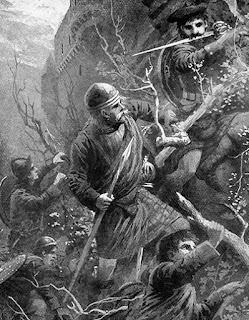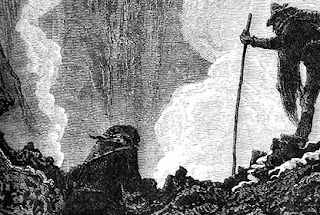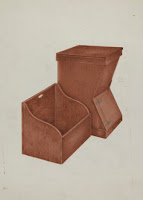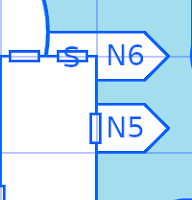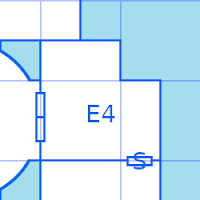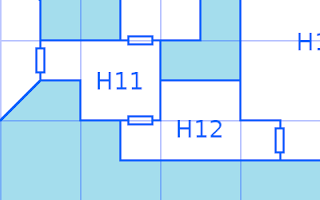 |
| The Leap was Made, unknown artist, retrieved from OldBookIllustrations.com. |
Alternative Combat Broke the Fighting Man
TL;DR - when playing D&D from the Basic era onward, the Alternative Combat System (or, the d20 system) was the default mechanism for combat resolution: taking into account the level of the attacker and the armor of the defender to determine hits and damage. However, this left the Fighting Man under-powered as the party advanced: dishing out small amounts of damage to singular opponents per turn and, as levels grew on, becoming more and more likely to take damage each round in the face of the meek consolation prize of added hit points.
This problem was not introduced by newer editions - but instead was an infection at the start with the Alternative Combat System. If, instead of using the ACS, a referee opted to use the Chainmail combat system, as prescribed by the original 1974 little brown books, Fighting Men became conversely over-powered: dishing out significantly more casualties in melee and becoming significantly harder to damage in combat (regardless of armor worn) as they leveled.
Thus, one of the most house-ruled aspects of OSR game play - the buffing of fighters to keep up with other character classes in relative impact - is fixed entirely not by looking forward, but by looking back. Intrigued? Read on.
What Are Hit Points?
Characters in all editions of the D&D game have hit points:
Hit points are a resource to be managed, a currency to help determined how much longer you should adventure. At its core, OSR D&D involves a lot of resource management - hit points fit that idiom: however, traps routinely kill on impact - a la poison darts or spiked pits - and other challenges (movement of large sums of treasure, negotiating with dungeon denizens, etc) rely more on player ingenuity than spending of hit points. Knowing this, and knowing that D&D evolved out of war-gaming, hit points fall squarely in the purview, primarily, of combat encounters.
The Riddle of Steel (or, Verisimilitude in Melee)
A consistent criticism of the alternative combat system - among the swinginess of the d20 and the lack of differentiation between weapon types and their intended uses - is the disconnect between being hit and weapon skill. That is, a character's chance to hit an enemy improves with time and levels: however, their chance to avoid being hit does not, instead only changing with level.
 |
| The Riddle of D&D Equipment, retrieved from KnowYourMeme.com. Image copyrights unknown; feel free to contact for proper attribution. |
A fighting man of first level who rolled decently on starting gold can afford plate and a shield - granting an armor class of 2. The same fighting man - 8 levels later, having achieved the point where a domain is assumed - still using the same plate and shield (plate and shield being the top tier armor provided in the equipment list) still has an armor class of 2. Compare this to the Character Attacks matrix on X26: the fighting man at level 1 requires a 17 to hit an AC of 2: or a 1 in 5 chance per attack. Conversely, the fighting man at name level 9 requires a 12 to hit an AC of 2: or 9 in 20, almost an even split between hits and misses. How is it that the Lord has learned so much about the art of bypassing defenses but literally nothing about improving his own?
What about Dexterity bonuses? While it is true that having a Dexterity a standard deviation above the mean or better does improve armor class, it does not change with level - excepting extreme circumstances, such as the use of a Wish to improve the stat or similar not-in-the-core-progression events. Thus, a fighter of level 1 and a fighter of level 9 with a common 14 Dexterity will still both have an AC of 1 instead of 2. Dexterity represents something innate to the character: not something that the character has earned with experience.
 |
| Thor i Kampen for Balder, by Louis Moe, retrieved from Wikimedia Commons. |
But the Lord has more hit points than the Veteran. Yes, he does. And there are folks who will point to the abstraction of hit points as a representation of health, stamina, luck, and skill - per the PHB guidance quoted above. When you run out, you die - but between 100% and 0, you're not necessarily losing blood. This falls apart, however, when you're talking about natural healing - RAW, a character can heal between 1 and 3 hit points daily: meaning that if the Lord has "parried" and "luck"ed their way out of death for 30 hit points (reasonable, knowing that a character of that level would have an average of 40 or 41 hit points), it's going to take at best 10 days for them to "heal" from it; conversely, the Veteran with an average of 3 or 4 hit points - 8, if your referee is generous and houserules max HP at level one - physically cannot take that long to heal any injury they take: as the absolute maximum number of days they can go is 7: having taken more damage than that resulting in death. It has been argued to me that this may represent muscle fatigue or similar - to which I replied, "Fair" - but the argument still doesn't hold water against the Veteran's maximum downtime of a week compared to the Lord being able to go potentially over a month before getting back up again.
What about magic armor? While, again, it is true that magical armor exists and does improve armor class beyond the basic level, it is not on the core progression of a character: that is, while it is common for a character to find at least one magic item by the time they've reached level 9, it is not guaranteed: and it is likewise not guaranteed that it will be a magical armor. When rolling for magical items, potions and scrolls make up half of the results - occupying a result of 36 to 85 on the d% roll. Armor, on the other hand, has a 1 in 10 chance of showing up: interestingly being half as likely as a magic sword is to appear (1 in 5, occupying the 1 to 20 position on the d%), but I digress.
 |
| Magic Dial, by Daniel Maclise, retrieved from OldBookIllustrations.com. |
That in mind, if you want to light up your players with deific magical artifacts, you're more than welcome to crack open 3.PF and do so: that discussion is outside the intended scope of this post.
Chainmail As Intended
|
Fighting Capability: This is a key to use in conjunction with the CHAINMAIL fantasy rule, as modified in various places herein.
Dungeons and Dragons, Book I: Men & Magic, p. 18
|
When meleed by regular troops, and combat takes place on the non-Fantasy Combat Tables, four simultaneous kills must be scored against Heroes (or Anti-heroes) to eliminate them. Otherwise, there is no effect upon them.
Chainmail, 3rd edition, p. 30 |
|
All attacks which score hits do 1-6 points of damage unless otherwise noted.
Dungeons and Dragons, Book I: Men & Magic, p. 19 |
|
In Chainmail, hit points don't exist. The armor a character wore and the level of the character determined how difficult they were to kill: with zero-level (or, first level, as may be) characters being treated as rank and file: akin to hirelings or even a player character out for their first delve. At a glance:
Mass CombatFor each participant, or set of participants, in combat, six-sided dice are rolled: inflicting casualties on a target number ranging between 4 and 6. |
Man to ManTwo participants strike each other using 2d6 - with casualties being determined based on weapon vs armor type and situational modifiers. |
Fantasy CombatThe Chainmail Fantasy Supplement introduces the Hero type - our proto-player character - which requires multiple hits to eliminate. |
It is from these rules that the LBBs extrapolated: the player characters equating to a set number of men, heroes, or superheroes - denominations of infantry in Chainmail - when in combat. Thus, it can be reasonably inferred that 1-6 points of damage are dealt to a character based on their level and the corresponding Chainmail combat table.
Defending Oneself
In Mass Combat, a Veteran is considered "Man + 1" in fighting capability: so, when wearing mail armor (akin to Heavy Foot troops), enemies considered Light would inflict 1-6 points of damage whenever a 6 was rolled; whereas a larger monster - say, a Heavy Horse - would inflict 1-6 damage whenever a 5 or 6 was rolled, but would be able to roll 3 dice in the attempt. When the character levels - advancing to Warrior - they are considered "2 Men + 1" in fighting capability; at level 4, the character advances to Hero: considered a "Hero" in fighting capability. By the book, a Hero requires four concurrent strikes to kill in a Chainmail game - as such, a player character Hero would, based on the above inference, require likewise four concurrent strikes to "hit" and deal 1-6 damage. Depending on the referee's interpretation, this may likewise extend to the Warrior: requiring two concurrent strikes to "hit" - as it would take two "kill" results in Chainmail to eliminate two men - but as I can't find explicit support for that in the RAW, this potential benefit must be at referee discretion. |
In Man to Man Combat, a single roll is required on 2d6, with a result to kill based on the weapon type versus the armor worn. This seems to reproduce the problem of subsequent editions, wherein you don't get more skilled: except at level 3, the Swordsman can fight as "Hero - 1": granting him access to Fantasy Combat.
In Fantasy Combat, a Hero can participate, as can a Super Hero: a rank at which a fighting man gains access at level 7. Notably, in Fantasy Combat, a hit is based not on your armor, but instead on your level and your opponent: a Hero, for example, must roll better than a 7 on 2d6 to hit another Hero; that same Hero, fighting a Super Hero on the other hand, must roll better than a 10. |
Higher level characters are thereby naturally harder to hit. The same is true across the board: the character then, as they ascend the tiers - Normal Man to Hero to Super Hero - become more difficult to hit as a byproduct of level.
On the Attack
Similarly, when attacking, higher level characters are more likely to inflict damage:
In Mass Combat, an LBB character fights as a number of men, or as a Hero or Superhero. This means that, when fighting in a skirmish scenario, a Veteran may roll 1 attack die, but a Hero will roll 4 attack dice at a time - more, if their armaments are effective against their opponent: for example, a Hero in plate with a lance on horseback would, when engaging Light Foot troops, roll 16 dice - scoring a kill (or, 1-6 damage, at least) on a 5 or 6: taking down 2 or 3 enemies per turn, on average. Take that, Cleave! |
In Man to Man, the fighting man again has a little advantage - Veterans counting as "Man + 1", Warriors "2 Men + 1", etc - implying that they should receive a bonus to their die rolls, per the note regarding Leaders. In Fantasy Combat, the fighting man - having ascended to Heroic status or better, is now able to go toe to toe with monstrous creatures: trolls, ogres, etc, which can fight as four, six, eight men at a time - or some of which are specified not to be vulnerable to normal men! |
 |
| Light Broke Forth, unknown artist, retrieved from OldBookIllustrations.com. |
Wizard and Cleric types improve also - defensively and offensively - with levels, albeit at a slower rate than do Fighting Men. A Fighting Man, for comparison, reaches "Hero" at level 4 and "Superhero - 1" at level 7:
| • | Magic Users fight as a Man initially, reaching "Hero - 1" at level 7 and then a special table, "Wizard," at level 10. |
| • | Clerics fight as a Man initially, reaching "Hero - 1" at level 6 and then "Superhero - 1" at level 9. |
These numbers should sound familiar: they are remarkably close to the level tiers at which, in the Character Attacks table of 1981's D&D Expert set (X26), character class groupings improve their to-hit against AC:
|
Fighters:
|
Clerics:
(and Thieves) |
Magic Users:
|
|---|---|---|
|
1-3 4-6 7-9 ... |
1-4 5-8 9-12 ... |
1-5 6-10 11-15 ... |
Higher level characters are thereby naturally more apt to damage each other - and to wade through less skilled adversaries - in melee.
Some Quick Math
To illustrate the differences in damage output, first, let's take a look at the amount of damage an OD&D and a 1981 Basic / Expert Fighter will deal, on average, against the three main armor types per round of a melee combat:
| OD&D Alternative Combat | ‘81 Expert Combat, with D8 Weapon | |||||
|---|---|---|---|---|---|---|
| Fighter Level | Plate | Chain | Leather | Plate | Chain | Leather |
| 1 | 0.7 | 1.05 | 1.4 | 0.9 | 1.35 | 1.8 |
| 2 | 0.7 | 1.05 | 1.4 | 0.9 | 1.35 | 1.8 |
| 3 | 0.7 | 1.05 | 1.4 | 0.9 | 1.35 | 1.8 |
| 4 | 1.05 | 1.4 | 1.75 | 1.35 | 1.8 | 2.25 |
| 5 | 1.05 | 1.4 | 1.75 | 1.35 | 1.8 | 2.25 |
| 6 | 1.05 | 1.4 | 1.75 | 1.35 | 1.8 | 2.25 |
| 7 | 1.575 | 1.925 | 2.275 | 2.025 | 2.475 | 2.925 |
| 8 | 1.575 | 1.925 | 2.275 | 2.025 | 2.475 | 2.925 |
| 9 | 1.575 | 1.925 | 2.275 | 2.025 | 2.475 | 2.925 |
| 10 | 1.925 | 2.275 | 2.625 | 2.475 | 2.925 | 3.375 |
Note, the tiers of to-hit actually match - so the accuracy does not change (that is, the required number to hit an adversary), but the second damage output table is included to represent the advent of the variable damage optional rule - wherein a sword-and-board fighter would be rolling larger dice.
Next, consider the damage output using Chainmail's Mass Combat system paired with OD&D's fighting capability matrix:
| OD&D and Chainmail: As Heavy | OD&D and Chainmail: As Armored | |||||
|---|---|---|---|---|---|---|
| Fighter Level | Armored | Heavy | Light | Armored | Heavy | Light |
| 1 | 0.58 | 1.17 | 2.33 | 1.17 | 2.33 | 3.50 |
| 2 | 0.58 | 1.75 | 3.50 | 1.75 | 3.50 | 5.25 |
| 3 | 0.58 | 1.75 | 3.50 | 1.75 | 3.50 | 5.25 |
| 4 | 1.17 | 2.33 | 4.67 | 2.33 | 4.67 | 7.00 |
| 5 | 1.17 | 2.92 | 5.83 | 2.92 | 5.83 | 8.75 |
| 6 | 1.75 | 3.50 | 7.00 | 3.50 | 7.00 | 10.50 |
| 7 | 1.75 | 4.08 | 8.17 | 4.08 | 8.17 | 12.25 |
| 8 | 2.33 | 4.67 | 9.33 | 4.67 | 9.33 | 14.00 |
| 9 | 2.33 | 5.25 | 10.50 | 5.25 | 10.50 | 15.75 |
| 10 | 2.33 | 5.25 | 10.50 | 5.25 | 10.50 | 15.75 |
Comparing the damage output, the damage output of an OD&D fighter with Chainmail Mass Combat is significantly higher than that of an OD&D fighter with the Alternate Combat System. Similarly, the damage output of an OD&D fighter with Chainmail Mass Combat is likewise generally higher than that of a B/X fighter using a larger damage die - d8 vs d6: especially when the player character is assumed to be an Armored troop type.
For further listening:
Regarding Chainmail and it's application to your home Fantasy Adventure Game, the Bandit's Keep Podcast, referenced in my review of the Bandit's Keep YouTube channel, is - as of this writing - likewise producing an audio series which dives into Chainmail in-depth and with an elan sufficient to pique interest.
Check it out!
On the whole - using the Chainmail system will both smooth out progression for damage output and will improve the effectiveness of the fighter in melee significantly more than the ACS does, RAW: something that future editions attempt to correct using multiple attacks (slowing down combat turns) or feats akin to Cleave (which only boosts damage in certain conditions and again, slows down combat turns). But, knowing what we know from having done the math above - these patches were glossing over a core problem with the original progression of the game: by moving away from the Chainmail system, a new problem was created that truly was never elegantly solved.
Full disclosure, two assumptions were made for the above table:
First, a fighter will be fighting either as a Heavy or an Armored combatant - as Chainmail examples for Heavy combatants as Vikings, Normans, etc. (who logically would be wearing chain-equivalent armor and fighting with axes or swords) and Armored combatants as dismounted knights or condottiere (who would logically be wearing plate and fighting either with heavier weapons or with greater panache) - to save space, and knowing a fighter in melee will usually not qualify as a Light troop (which tend to be unarmored peasant levies or missile troops not intended for melee), no calculations were included for Light troop damage.
Second, the Fighting Capability matrix provides +1 or -1 modifiers to the character's "counts as:" e.g. - a Champion, fighter level 7, fights as "Superhero - 1." The only reference I could find in Chainmail in the Mass Combat section pertaining to bonuses was that "Men armed with a pike or halbard add an extra die" (Chainmail, p. 40) - as such, where "Man + 1" is present in the table, I assumed that the character would modify the dice pool to which they were entitled by 1: essentially, where a Heavy Foot strikes another Heavy Foot, they roll 1 die per man, connecting on a 6 - a character identified as "Man + 1" in the table above would instead roll 2 dice.
Bonuses to rolls make more sense in the context of the Man to Man or Fantasy Combat tables - but regarding modification of the dice pools, it seems to work, too - as the math goes... horribly wrong if you apply the modifier to the dice roll, itself - such that the aforementioned Champion, if a -1 is applied to the dice they roll to attack, actually deals less damage per round in combat than several levels below him. This does not work in some of the other tables - that is, for example, a Magic User fights as "Man + 1" at level 2 and "2 Men" at level 3 - but that's beside the purpose of the table. If you want the +1 to apply only in Man to Man or Fantasy Combat? Do that instead (and tell me how it goes!).
 |
| Battles, by Adolf Ehrhardt, retrieved from OldBookIllustrations.com. |
But what about defense? A character advancing from Normal Man to Hero to Super Hero, as described above, can expect to be hit less frequently. Consider the following, wherein the probability of a character at each Chainmail tier, based on their troop type, is likely to take at least one hit from an adversary or set of adversaries, based on troop type, attacking with a given number of dice:
| as Normal Man | as Hero | as Super Hero | |||||||
|---|---|---|---|---|---|---|---|---|---|
| Light Opponent |
Armored | Heavy | Light | Armored | Heavy | Light | Armored | Heavy | Light |
| 1 | 0.00% | 0.00% | 16.67% | 0.00% | 0.00% | 0.00% | 0.00% | 0.00% | 0.00% |
| 4 | 16.67% | 30.56% | 51.77% | 0.00% | 0.00% | 0.08% | 0.00% | 0.00% | 0.00% |
| 8 | 30.56% | 51.77% | 76.74% | 0.00% | 0.08% | 3.07% | 0.00% | 0.00% | 0.00% |
| 12 | 51.77% | 66.51% | 88.78% | 0.08% | 0.87% | 12.52% | 0.00% | 0.00% | 0.02% |
| Heavy Opponent |
|||||||||
| 1 | 0.00% | 16.67% | 33.33% | 0.00% | 0.00% | 0.00% | 0.00% | 0.00% | 0.00% |
| 4 | 30.56% | 51.77% | 80.25% | 0.00% | 0.08% | 1.23% | 0.00% | 0.00% | 0.00% |
| 8 | 51.77% | 76.74% | 96.10% | 0.08% | 3.07% | 25.86% | 0.00% | 0.00% | 0.02% |
| 12 | 66.51% | 88.78% | 99.23% | 0.87% | 12.52% | 60.69% | 0.00% | 0.02% | 1.88% |
| Armored Opponent |
|||||||||
| 1 | 16.67% | 33.33% | 50.00% | 0.00% | 0.00% | 0.00% | 0.00% | 0.00% | 0.00% |
| 4 | 51.77% | 80.25% | 93.75% | 0.08% | 1.23% | 6.25% | 0.00% | 0.00% | 6.25% |
| 8 | 76.74% | 96.10% | 99.61% | 3.07% | 25.86% | 63.67% | 0.00% | 0.02% | 63.67% |
| 12 | 88.78% | 99.23% | 99.98% | 12.52% | 60.69% | 92.70% | 0.02% | 1.88% | 92.70% |
The above assumes nothing regarding bonuses to dice and is tiered to the RAW character levels: that is, it does not assume the potential ruling that a Swordsman - fighting as 3 men - would take 3 simultaneous hits to deal damage and, noting the 0% chance hits per round, there exists in Chainmail the condition that a troop type can be invulnerable to other unit types: namely, Heavy Foot troops gain an attack die every other man attacking - so, 2 men would roll 1 attack die - against Armored Foot troops: a number which increases even more for Light Foot or when fighting against mounted opponents. A Hero in Chainmail is only wounded if four concurrent hits are struck in a round: meaning that either another Hero must attack them and get lucky or a group comprised of at least four dice worth of men are required to deal damage to them.
Regardless of house rules and potentialities, again, this illustrates that - as the character levels, they become less likely to be damaged by opponents of lower level unless severely outnumbered: in addition, when fighting against opponents of equivalent level, a character's armor is the prime determinant to damage taken. And, of course, if a combatant is fighting against an opponent of tier higher than themselves - e.g. a Heavy opponent fighting as 6 men against a Normal Man - armor helps, but its impact is blunted by an increased likelihood to receive hits.
Notably, "0%" appears in abundance as a character reaches the tier of Super Hero in combat - at which point, two Super Heroes in equivalent kit appear unable to hurt each other in mass combat. Although this is more so a result of rounding in the table - the Super Hero can roll all 6s on the 8 dice in their attack, inflicting a hit on another Super Hero one in 1,679,616 turns - but more appropriately: that's the point at which the Referee should break out the Man to Man or Fantasy Combat tables instead!
In Conclusion
 |
| The Battle of St. James at Clavijo, by Martin Schongauer, retrieved from the National Gallery of Art. |
Chainmail fighters - and truthfully, all combatants - are more capable at higher level in melee than are their corresponding counterparts in the Alternate Combat System. Additionally, the inclusion of Hit Points in the Little Brown Books, working in tandem with the Chainmail rules, provides more durability - but not extreme durability - to player characters: something that will allow the player to get more invested in the character as they advance in power.
I encourage everyone to try Chainmail at least once in this context, as it will satisfy your concern for the verisimilitude problem that the ACS introduces while at the same time effectively balancing your Fighting Men: improving their effectiveness in melee smoothly and more effectively than patches coming in from future editions.
Thanks for reading!
Citations and Fair Use Disclaimer
Quotations and rules from the following copyrighted works are included herein for illustrative and educational purposes and remain the intellectual property of the copyright holder - as of October 2020, Wizards of the Coast LLC. Neither the author nor Clerics Wear Ringmail lay claim to the verbiage nor mechanics quoted but instead encourage the reader to engage with and enjoy the product referenced for their intended purpose.
Arneson, D., & Gygax, G. (1974). Dungeons & Dragons Book I: Men & Magic. Lake Geneva, WI: Tactical Studies Rules.
Cook, D., & Marsh, S. (1981). Dungeons & Dragons: Fantasy Adventure Game Expert Set. Lake Geneva, WI: TSR Hobbies Inc.
Gygax, G., & Perren, J. (1979). Chainmail: Rules for Medieval Miniatures, 3rd Edition. Lake Geneva, WI: TSR Rules.




